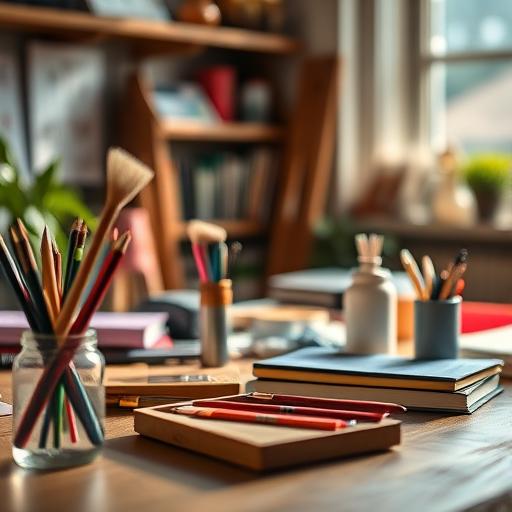The Modern Struggle for Focus
Does your brain ever feel like it has too many tabs open? Between work emails, social media notifications, and the endless stream of news, our attention is constantly being pulled in a million different directions. This state of perpetual distraction can leave us feeling drained, anxious, and disconnected from ourselves. Finding activities that help us ground ourselves is essential, and engaging in Hobbies for Mental Health is a fantastic way to reclaim your peace of mind.
This constant mental clutter makes it difficult to concentrate on what truly matters, leading to a sense of being overwhelmed and mentally fatigued. Creative hobbies offer a powerful antidote. They provide a dedicated space and time to unplug from the digital noise and plug into your own inner world. By directing your attention to a single, enjoyable activity, you give your mind a much-needed break from the chaos and a chance to reset.
The Science Behind Creativity and Calm
When you get lost in a creative activity, you might experience a state of “flow.” This is a psychological concept describing a feeling of complete absorption in an activity, where time seems to fly by and outside worries fade away. During flow, your brain releases dopamine, a neurotransmitter associated with pleasure and reward, which naturally improves your mood and motivation. This is your brain on pure, joyful focus!
Many creative pursuits, such as knitting, pottery, or even detailed coloring, involve repetitive motions that are incredibly soothing for the nervous system. These rhythmic actions can induce a state similar to meditation, lowering your heart rate and reducing levels of the stress hormone cortisol. It’s a simple yet effective way to quiet anxious thoughts and promote a deep sense of relaxation and well-being. 🧘♀️
Painting and Drawing: Your Canvas for Clarity
Putting a brush to canvas or a pencil to paper is a wonderful way to communicate without words. Painting and drawing allow you to process feelings and ideas in a visual format, which can be incredibly liberating. The focus required to mix colors, create shapes, and form lines draws you into the present moment, offering a true escape from day-to-day stressors. It’s a chance to make your mark, quite literally.
You absolutely do not need to be a professional artist to benefit from these activities. The goal isn’t to create a masterpiece for a gallery; it’s about the simple act of creating. Grab some crayons, a sketchbook, or a simple watercolor set and just play. Doodling during a phone call or sketching a plant on your desk can be a small but powerful way to clear your head and find a moment of peace. 🎨
Writing and Journaling: Expressing Your Inner Voice
Your thoughts and feelings can sometimes feel like a tangled mess. Writing, whether in a journal, as poetry, or through short stories, is a way to untangle them. It provides a private space to explore your emotions without judgment, helping you gain clarity and perspective on what’s on your mind. Getting it all out on paper can make even the biggest worries feel more manageable.
There are no rules when it comes to therapeutic writing. You could try a “brain dump,” where you write down everything you’re thinking for ten minutes straight without stopping. Or, you could write a letter you never intend to send. The physical act of writing helps externalize your thoughts, creating a healthy distance that allows for reflection and emotional release. ✍️
Music and Melody: The Soundtrack to a Better Mood
Music has a direct line to our emotions. Learning to play an instrument, like a guitar or piano, is a full-brain workout that demands your complete attention. The concentration needed to coordinate your hands, read music, and listen for the right notes leaves little room for anxious thoughts to creep in. It’s a rewarding challenge that builds new neural pathways and fills your home with beautiful sounds.
You don’t have to be a musician to reap the benefits. Simply listening to music can drastically alter your mood. Creating playlists that match or shift your emotional state can be a creative act in itself. Singing along to your favorite songs in the car is also a known stress-reliever; it releases endorphins and can leave you feeling energized and happy. 🎶
Crafting and DIY Projects: Building More Than Just Objects
Hobbies like woodworking, knitting, pottery, or sewing offer a unique satisfaction that comes from creating something tangible with your own hands. Completing a project, whether it’s a scarf, a wooden box, or a piece of pottery, provides a powerful sense of accomplishment. This boost in self-esteem can be a wonderful antidote to feelings of helplessness or low confidence.
The structured, step-by-step nature of many crafts is comforting to a worried mind. Following a pattern or a set of instructions gives your brain a clear path to follow, reducing mental ambiguity and promoting a sense of order. The end result is not just a beautiful object, but also a stronger sense of your own capability and resilience.
How to Choose the Right Creative Hobby for You
Think back to what you loved doing as a child. Did you spend hours building with LEGOs, drawing comics, or making up stories? Those early passions are often a great indicator of what you might enjoy now. The goal is to reconnect with your sense of play and curiosity, so don’t put pressure on yourself to be perfect. Give yourself permission to experiment and be a beginner again.
Start with something that has a low barrier to entry. You don’t need to buy the most expensive art supplies or a top-of-the-line sewing machine. Pick up a simple sketchbook, a ball of yarn and knitting needles, or a beginner’s ukulele. The most important thing is to find an activity that feels like a treat, not another chore. Your new hobby should be a source of joy and a peaceful retreat from the busyness of life.
